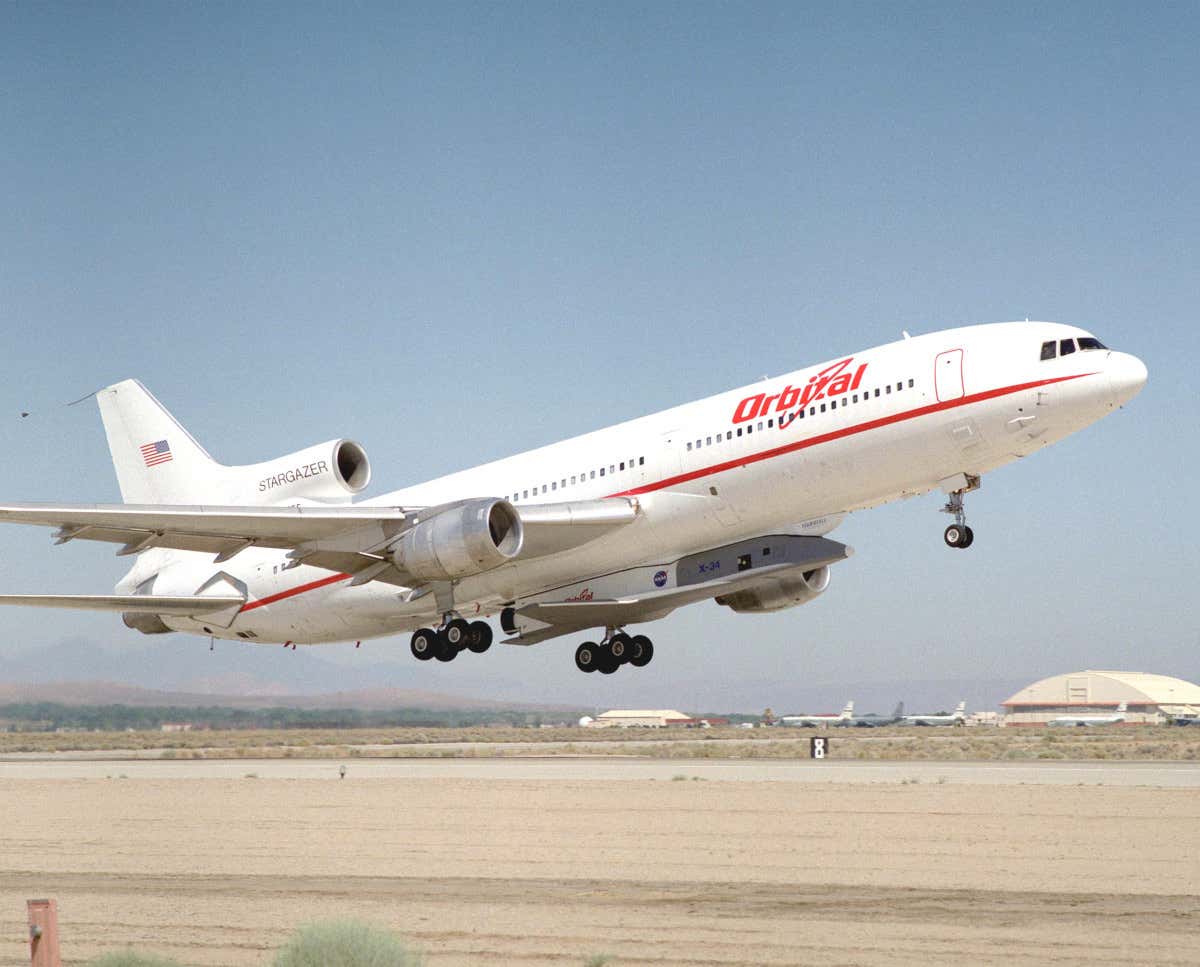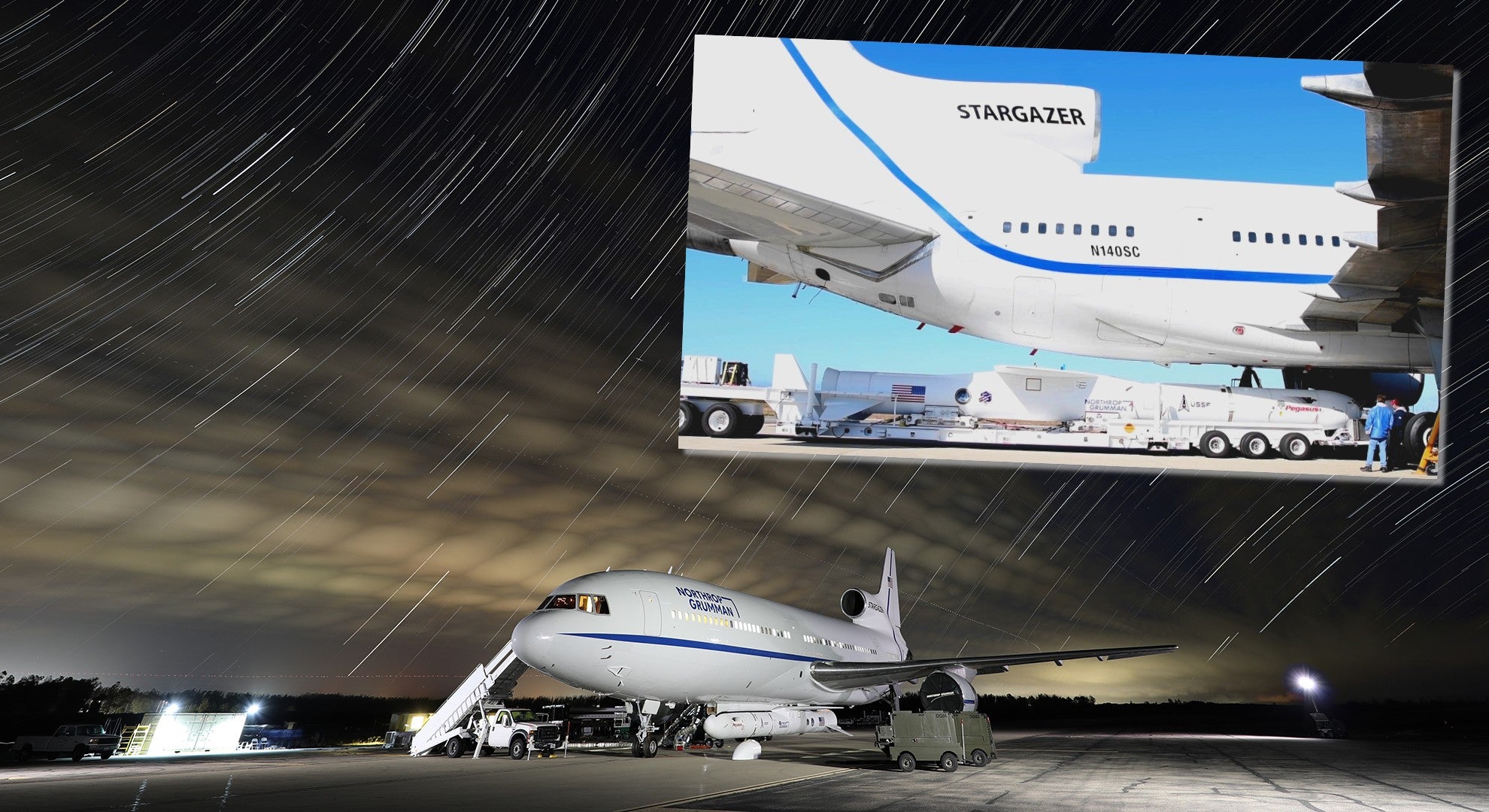The United States Space Force (USSF) launched a Northrop Grumman Pegasus XL rocket carrying a satellite from the L-1011 Stargazer carrier aircraft over the weekend, marking a milestone in terms of how rapidly the United States can develop and launch a satellite. The entire design, integration, and testing phase of the Tactically Responsive Launch-2 (TacRL-2) vehicle carrying the satellite took just four months, less than a fifth of the time the launch process usually takes. Being able to put satellites in orbit with such a short development cycle represents a radical new capability for the Space Force and the Department of Defense (DOD) as a whole.
In the Pegasus Payload User Guide, Northrop Grumman writes that “the procurement, analysis, integration, and test activities associated with the Pegasus launch of a payload typically occur over a 24- to 30-month baseline mission cycle.” For this most recent launch, however, that mission cycle was under four months. “This Pegasus launch was a clear demonstration of our team’s ability to provide rapid and responsive operational needs,” said Northrop Grumman’s vice president of launch vehicles, Rich Straka. “Our team was able to execute the design, integration and testing of the TacRL-2 launch vehicle in less than four months from contract award.”
U.S. Space Command (USSPACECOM) issued a statement the day after the launch, adding that one of the goals of the TacRL-2 mission was to simulate the “rapid reconstitution” of space capabilities to ensure there would be no gap in space-based missile detection and warning in the event of a satellite being damaged or rendered inoperable. “During conflict, the ability to rapidly reconstitute degraded systems within hours forces adversaries to rethink the economic benefit of attacking on-orbit assets,” said U.S. Army Gen. James Dickinson, commander of USSPACECOM.

The exact details of the integrated Space Domain Awareness satellite, nicknamed “Odyssey,” remain undisclosed, but the USSF reports that the satellite was built and operated by the Air Force Research Laboratory and Space Dynamics Laboratory. The Pegasus XL rocket carrying the TacRL-2 payload including the Odyssey satellite up to orbit over the weekend was flown to its launch position aboard Northrop Grumman’s heavily modified Stargazer aircraft, the only Lockheed L-1011 Tristar still flying today.
The Stargazer frequently launches experimental or secret payloads and typically operates out of the Mojave Air and Space Port. The Stargazer and its payload departed Vandenberg Space Force Base on Sunday, June 13, with launching taking place at 4:11 a.m. EDT. Navigational warnings for its launch window were issued just days before:
In a Space Force statement, USSF Chief of Space Operations Gen. John W. “Jay” Raymond, said the Space Force’s “call-up” of the satellite took place on an even shorter timeline after the TacRL-2 payload had been designed and tested:
The space domain is defined by speed. And with this effort, we demonstrated the kind of speed it will take to win. We executed a ‘21-day call-up’ to get a satellite on orbit – pulling the payload, mating it with the rocket and integrating the combined package onto the aircraft. Agile, responsive capability development, combined with our ability to rapidly launch and insert capabilities into space where we want, when we want, will deny our competitors the perceived benefits of beginning a conflict in, or extending a conflict to, space.
The most recent Space Force launch was part of its “Tactically Responsive Launch” program, defined by the USSF as “the first step toward the USSF acquiring a tactical space mobility and logistics capability to support combatant command’s future requirements for tactical spacepower.” The Space and Missile Systems Center (SMC) recently stood up the “Space Safari Program Office” in order to “respond to high priority needs to deploy space systems quickly to respond to emerging threats.”
“Where most space vehicles take years to deliver, and launches are similarly planned years in advance, this ability to quickly integrate and launch will result in greatly enhanced capabilities for America’s Space Force,” said SMC Director of Special Programs Col. Dennis Bythewood about the Space Safari Program Office.

Rapid air launches such as the TacRL-2 mission have become an increasing part of the U.S. military’s space strategy in recent years. In 2019, the U.S. Air Force conducted its first ever satellite launch from Guam using Virgin Orbit’s Cosmic Girl, a modified Boeing 747 mothership, in support of the Rapid Agile Launch Initiative (RALI) which also explored rapid and responsive space access concepts. Even reusable space planes have been eyed for placing small satellites into orbit quickly.
These types of launches could enable the insertion of payloads into orbit quickly and unpredictably, or, more importantly, enable the rapidly replacement of satellites that are lost or disabled during a time of war. As global superpowers jockey for dominance of the space domain, constellations of rapidly replaceable or reconfigurable satellites will be key to maintaining the space-based capabilities the U.S. military increasingly depends on during a time of war. DOD leaders have even suggested that a “show of force” in space may be needed to deter our adversaries, and it may be that launches such as the TacRL-2 are intended to demonstrate just how rapidly the US can put satellites in orbit, making hostile nations wary of wasting resources on anti-satellite operations. Compressing this timeline even further is most certainly another goal of the Tactically Responsive Launch program and other similar initiatives.
These types of public launches taking place on proven system such as the combination of Stargazer and Pegasus XL are just tip of the iceberg when it comes to rapid launch concepts, and there are almost certainly other space access programs underway in the classified realm, as well. What is clear, however, is that the Space Force and the DOD have made rapid space access a major priority moving forward, as demonstrated by the incredibly short timeline of the recent TacRL-2 mission.
Contact the author: Brett@TheDrive.com
